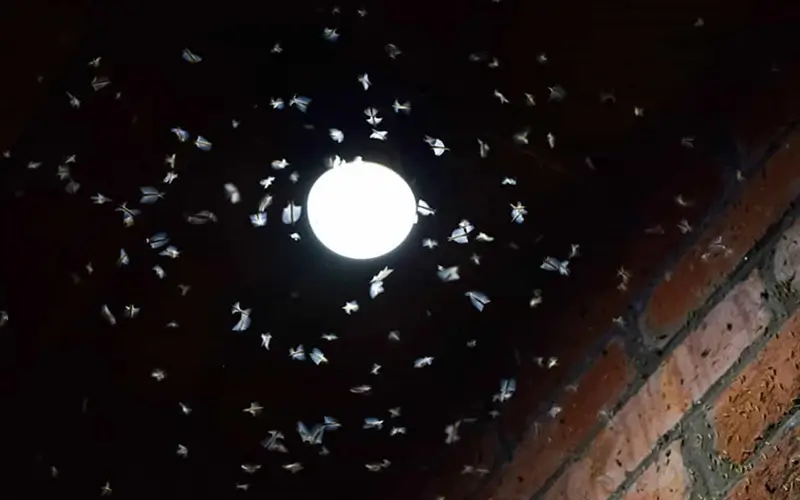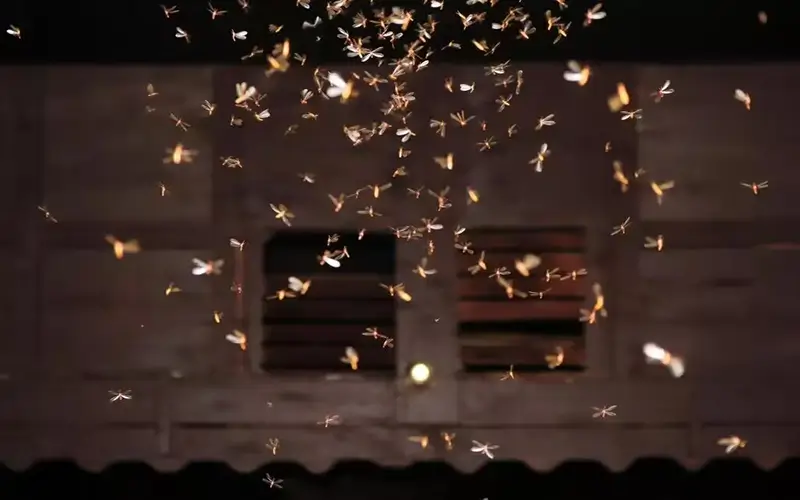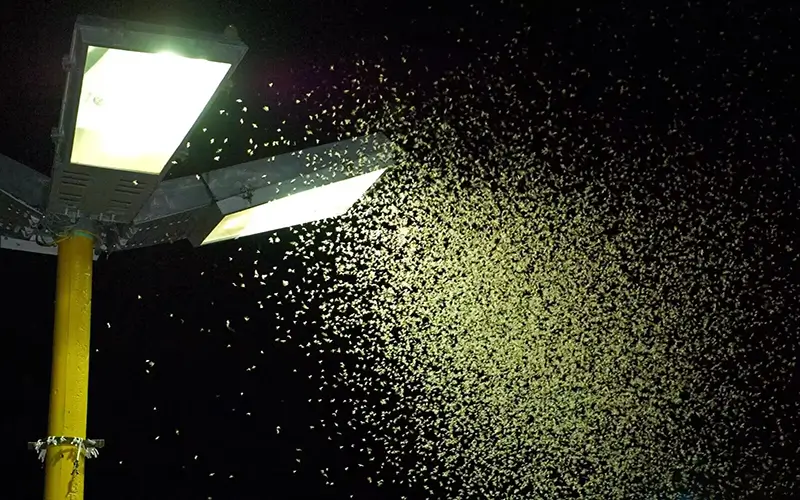
After sunset. When we turn on the outdoor lights, we will find that there are many flying insects, moths, flies, and other insects gathered in the lights. It’s the light source that attracts bugs. We resort to bug zappers, sprays, or citronella, but that doesn’t completely repel the bugs. So have you ever thought about using LED lights outdoors? Do LED Lights Attract Bugs?
This article mainly talks about some important facts about whether LED lights attract bugs, how to attract bugs, and how to repel bugs. It can help everyone to operate better.
Will LED Lights Attract Bugs?
It turns out that LED lights do attract bugs. In fact, LED lights don’t get as hot as other lights, so they’re generally less likely to attract bugs. However, because many LEDs are exceptionally bright, they emit blue and white light. This is exactly the kind of light bug.

What are the Factors that Attract Bugs to LED lights?
Why do LED lights attract bugs? Here are the factors that bugs are likely to be most interested in.
Color Temperature
Different color temperatures can also attract bugs. In general, insects tend to be less active during the day if there is too much sun and heat.
However, they become very active at night. This is because they seek out warm places to escape the cold at night. As a result, LED lights produce a color temperature range of 3,500-4,000 Kelvin and have a neutral white light. Thus, this type of light acts as an insect or bug attractant.
Color Rendering Index
The Color Rendering Index (CRI) is a scale that measures how well colors appear under various light sources versus natural sunlight. The index ranges from 0 to 100, where a perfect 100 means the color under the light source looks the same as it does in nature. color fidelity
It is precisely because of the higher degree of color rendering; the color is true and clear. So the color is more attractive to insects.
Therefore, LED lights with high color temperature, luminous ratio coefficient, and high color rendering index will attract more bugs.
Brightness Scale Factor
The brightness ratio of the LED light is about 1,100 lumens. This type of LED emits a warm white light that doesn’t affect the behavior of the bugs. As a result, bugs can easily fly or roam around the LED light and start clogging the light source. Therefore, be sure to avoid using high-brightness LED lights.
Which Type of LED Lights Won’t Attract Bugs?
In the manufacturing process of LED lamps, the primary problem is that the lumens are too high. How to prevent insects from flying over? First you need to check the color temperature of the LED light.
LED lights with a color temperature range of 5,000 Kelvin will emit light similar to daylight. It also produces excess blue light in the 400-500nm range. Therefore, insects are nocturnal in nature, so they are attracted to this light shade.
Conversely, sticking to warm amber light shades will make them less attractive to bugs. Therefore, warm colors help prevent the LED lights from attracting bugs. But instead, if you use brightly colored LEDs, you may have trouble attracting bugs.
LED Lights That Can Help to Prevent Bug Attraction

If you want to brighten up your outdoor environment with LED lights and reduce the bugs that disturb your atmosphere at the same time, you can reference the below information.
- Select LED Bug Light. Because it is a type of lamp with a yellow coating, this coating helps to reduce the color temperature of the illuminating light.
- Yellow-coated bulbs help keep bugs out, and many other bulbs have a similar function. Exceptions, yellow strip lights, and gold filament bulbs are great for setting the scene. This helps prevent bugs from being attracted to the light source.
- Some LED lights emit warm light. So, LED lights with a higher color temperature attract the least bugs.
- Also, you might buy LED lights that are specifically designed to keep bugs from being attracted or kill them. They can also be used as LED bulbs at the same time. This way, you can install these types of LED lights directly instead of using traditional pest control strategies.
What Color LED lights will attract bugs?
As mentioned above, color temperature affects bug behavior. Therefore, the color emitted by any light source has the potential to attract bugs. However, mosquitoes or bugs are more likely to see colors with shorter wavelengths, such as cyan and ultraviolet light. So, the colors yellow, red, and orange that have relatively long wavelengths tend to attract fewer bugs.
However, LED lights do not emit UV light, so they are ideal for use around insects. However, LED lights sometimes emit light with shorter wavelengths, such as blue or white light. This seems cumbersome as it attracts bugs to a large extent.
If you’re using LED lights outdoors, be sure to check their wavelength. It is critical to choose a bulb with a wavelength greater than 550n. Also, its color range should be warm, yellow, or super warm white. With these colors in mind, you’ll want to invest in the right LED lights that will repel bugs while also complementing your surroundings.
Alternate Ways to Keep Bugs Away from LED Lights
There are a few other traditional ways of keeping the bugs away from lights. So, let’s go through them briefly:
Switching off excessive LED lights might prompt fewer bugs zooming around. A solitary light will not be the main thing that discourages annoying creepy bugs.
When bugs are prowling close by, particularly around entryways, there’s a possibility they’ll discover their way inside. In that case, you need to be aware of the four primary things that bugs need to survive. These things include food, water, a place to live, and appropriate temperature.
Thus, if you need to ward them off, you additionally need to keep those essential requirements from them.

Consider Practicing These Different Tactics:
Except that the LED light itself will attract bugs, now we can use some other traditional methods to keep insects away from the light as follows.
- Dispose of stagnant water. Make sure you have proper drainage in your garden. Change the water in the pots frequently and dispose of any remaining water.
- Check your screen often. Bright lights from your home can also attract bugs. You have to make sure your windows and entry screens are a good fit.
- Repair the entry channel seal. The lower part of the entryway must be sealed so that bugs cannot enter the passageway.
- Keep open spaces clean. Take out the trash every day and keep the trash cans clean. Also, keep trash cans away from entrances and windows.
- You can also use herbal-infused sprays, which will help keep bugs away, especially near doors and windows.
Conclusion
It turns out that no spectrum can completely keep bugs away from lights. Because every color spectrum attracts bugs. But we can try our best to use some measures to get rid of insects. And provide you with a soothing and calm environment.
But LED lights do go a long way in not attracting and repelling bugs, and LED lights can help to a great extent. You need to start using LED lights with longer wavelengths and a color range of warm white to yellow.
So, replace your old incandescent bulbs with LED bulbs to create a safe atmosphere and keep bugs away.
FAQs
Yes, LED lights do attract bugs, just to a lesser extent than traditional incandescent or fluorescent lights. The color temperature and wavelength of an LED light can affect its attractiveness to insects as well.
Insects are attracted to all light sources because they use natural light cues for navigation. The spectrum and intensity of the light emitted by the LEDs can mimic moonlight or sunlight, thereby confusing insects and guiding them toward the light source.
Bugs are often attracted to the shorter wavelengths of the spectrum, such as ultraviolet (UV) and blue light. Therefore, blue and white LED lights tend to attract more insects than warm LED lights.
Yellow LED lights are less attractive to bugs than white or blue lights. Bugs perceive yellow light as less intense and less similar to sunlight, making them less attractive to these light sources.
Some LED lights are marketed as insect repellent because the way they emit light is less attractive to insects. They usually come in yellow or amber and emit less ultraviolet light.
LED lights generate less heat than traditional incandescent lights, another factor that attracts bugs. Additionally, LEDs can be designed to emit specific wavelengths of light that are less attractive to insects.
